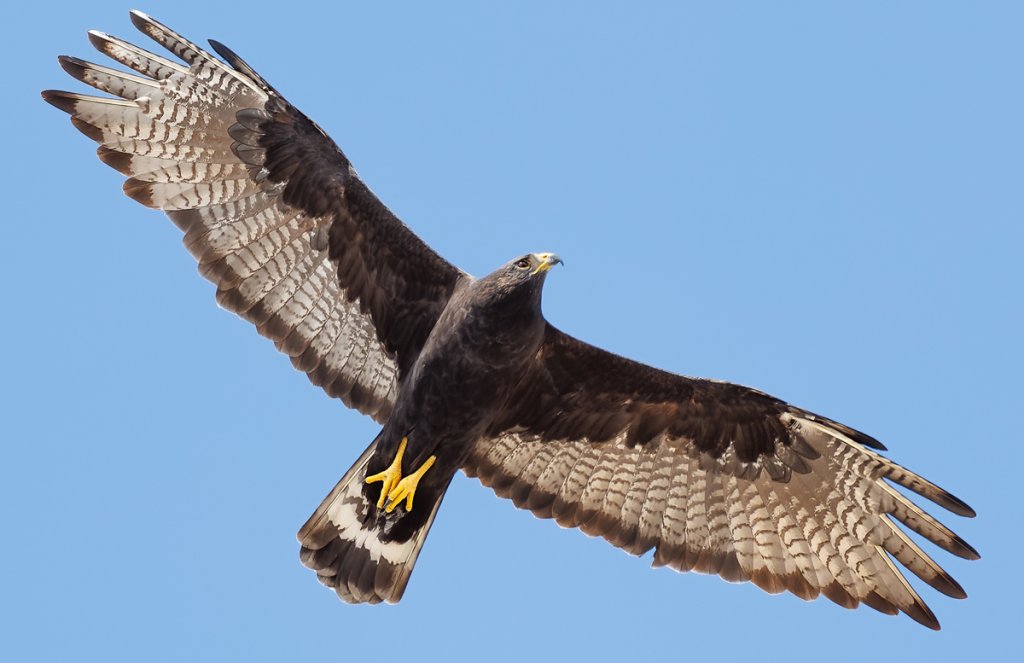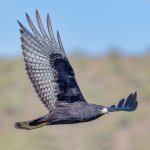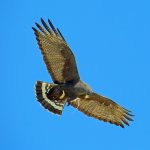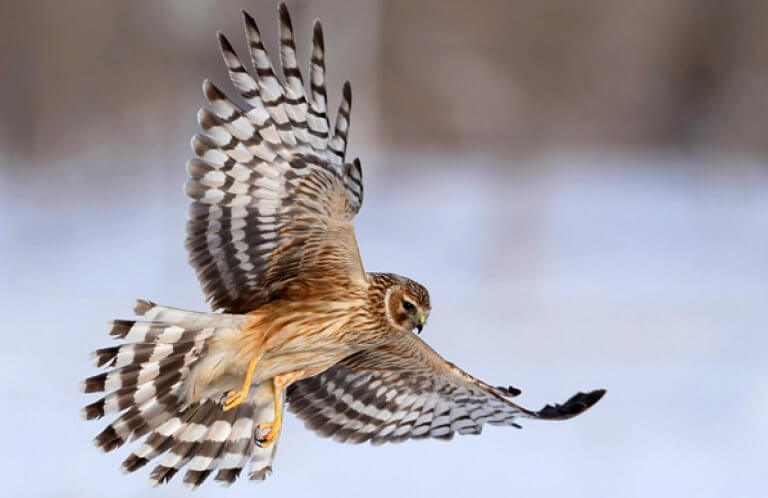About the Zone-tailed Hawk
The Zone-tailed Hawk is a large, dark raptor with a wide, but disjunct, range that barely reaches into the southwestern United States. It's about the size of a Red-tailed Hawk, but noticeably slimmer. Perched, this hawk appears blackish, but in flight, reveals finely-barred gray flight feathers that can appear silvery from a distance. Its tail has three light-colored bands, or zones, which give this bird its common name. Yellow legs and a yellow and gray bill round out the Zone-tailed Hawk's most noticeable ID features.
In flight, the Zone-tailed Hawk's color, size, and flight style resemble those of another large, widespread raptor species, the Turkey Vulture.
Deadly Deception
As a Zone-tailed Hawk soars, it holds its wings in a V-shaped dihedral and rocks from side to side, a flight style that mimics a Turkey Vulture's. The hawk's dark color and silvery-looking underwings also effectively mimic the appearance of the vulture, and Zone-tailed Hawks will even join groups of Turkey Vultures in flight.
Many biologists believe that this copycat appearance and behavior allows the Zone-tailed Hawk to get close to its prey, which are not normally wary of the non-predatory, scavenging Turkey Vulture. By the time the deception is clear, it's too late, and the Zone-tailed Hawk secures an easy meal.
Songs and Sounds
The Zone-tailed Hawk's has a rather mournful-sounding, downward-slurring call.
Listen to an adult calling here:
Breeding and Feeding
Aerial Antics
Zone-tailed Hawk pairs put on eye-catching courtship displays that include aerial loops, dives, and rolls, reaching heights of over 1,500 feet. A mated pair works together to build a large platform nest of sticks in tall tree, often lining the structure with greenery that may act as natural pest repellent. Nests may be reused from year to year. Zone-tailed Hawks are aggressive nest defenders, attacking birds as large as the Golden Eagle in their nesting territories. They will even chase unwary humans that invade their nesting space.
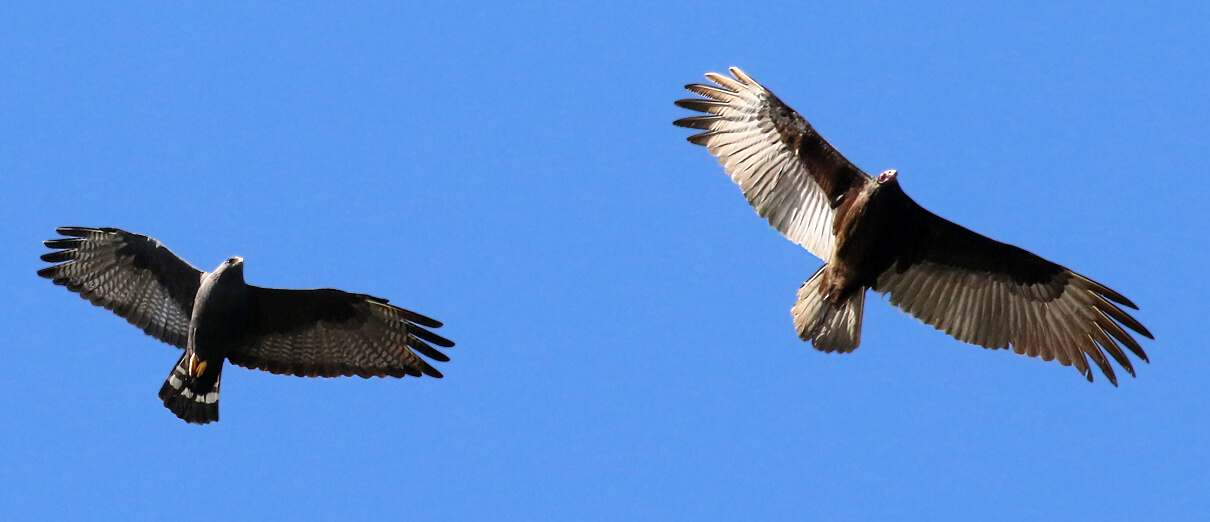
The female Zone-tailed Hawk lays an average of two eggs, which she incubates for roughly a month. Her mate brings her food as she tends the nest and sometimes continues to provide it after their downy gray young hatch. As is common in other raptors such as the Great Horned Owl, the first chick usually kills its younger, smaller sibling. This seemingly cruel behavior, known as siblicide, has a practical purpose: only the strongest chick will make it to adulthood. The young Zone-tailed Hawks fledge at about a month and a half, and will remain in the vicinity of the nest, being fed by their parents, for another several weeks.
The Zone-tailed Hawk has a varied diet that includes birds, small mammals, and reptiles, particularly lizards. It hunts using several strategies; in one, it soars high with wings raised in a dihedral position like a Turkey Vulture, then stoops on its unsuspecting prey. It may also course low over the ground like a Northern Harrier, dropping behind cover and getting as close as it can to its prey before striking. It sometimes even snatches prey from tree branches and treetops as it flies, in the manner of a Swallow-tailed Kite.
Region and Range

Zone-tailed Hawks reach the northern end of their range in the United States, breeding in Arizona, New Mexico, and Texas. These populations migrate short distances, sometimes joining flocks of migrating Turkey Vultures, south into Mexico and Central America for the winter.
The majority of Zone-tailed Hawks are found in Mexico, Central America, and South America, most as permanent residents. The species is also native to Trinidad. The Zone-tailed Hawk is uncommon throughout its range, for reasons not fully understood.
Conservation
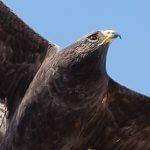
Help support ABC's conservation mission!
Although the Zone-tailed Hawk is not formally listed as Endangered, the species is threatened by habitat loss in the U.S., particularly in Arizona, where many suitable nesting areas have been taken over by agriculture and human development. This hawk is also vulnerable to human disturbance at the nest. Zone-tailed Hawks in Mexico and Central and South America may be impacted by pesticide use.
The Zone-tailed Hawk has been noted at over 20 ABC-supported reserves throughout the Americas, from the Paton Center for Hummingbirds in Arizona to the El Dorado Reserve in Colombia, Buenaventura Reserve in Ecuador, and the Barba Azul Reserve in Bolivia.
Get Involved
Policies enacted by the U.S. Congress and federal agencies, such as the U.S. Fish and Wildlife Service, have a huge impact on migratory birds. You can help shape these rules for the better by telling lawmakers to prioritize birds, bird habitat, and bird-friendly measures. To get started, visit ABC's Action Center.
Living a bird-friendly life can have an immediate impact on migratory birds in the United States. Doing so can be as easy as adding native plants to your garden, avoiding pesticides, and keeping cats indoors. To learn more, visit our Bird-Friendly Life page.
American Bird Conservancy and our Migratory Bird Joint Venture partners have improved conservation management on more than 8.5 million acres of U.S. bird habitat — an area larger than the state of Maryland — over the last ten years. That's not all: With the help of international partners, we've established a network of more than 100 areas of priority bird habitat across the Americas, helping to ensure that birds' needs are met during all stages of their lifecycles. These are monumental undertakings, requiring the support of many, and you can help by making a gift today.





































